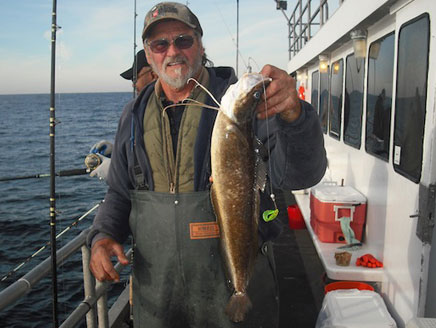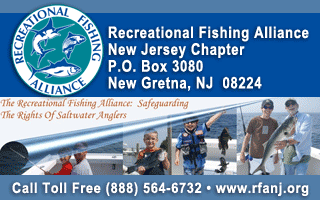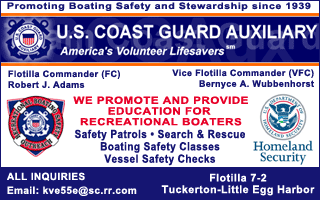
Some fishermen just find it difficult to quit...no matter what time of the year it is...
By Tom Vassallo
By now, most Jersey anglers have packed up their reels, hung up the rods and are waiting for the warm winds of Spring. For many of them, if it doesn't have stripes...it just isn't worth their time. However, some fishermen just find it difficult to quit...no matter what time of the year it is. That special breed still puts on the thermals, dons their warmest coveralls and heads to a party boat or back to the surf. Back to the surf? Man, those big linesiders are long gone in search of warmer waters. What the heck are you gonna catch this time of year?
As the colder water temps drive the striped bass and bluefish south, they also tend to heat up the fishing for species that we won't normally see off the Jersey coast in late spring and summer. When the autumn New England waters cool, other species of fish migrate south where many will winter in New Jersey's somewhat "warmer" winter waters. Those winter species include cod, pollock, red hake (commonly called "ling") and silver hake (referred to by many as "whiting"). These species are delicious to eat when handled properly and eaten fresh. Smoked whiting is also considered a delicacy by many. Any of these fish should be bled immediately when caught and kept on ice even in frigid temperatures. Pollock and the hakes are best eaten fresh, as their meat can become "spongy" when frozen too long.
Members of the Cod family will endure central Atlantic water temperatures that approach the freezing mark. Why in some Northern Atlantic areas near Scandinavia, cod remain active in Artic waters that are at sub-zero temperatures! This is due to the fact that they produce a literal "anti-freeze" protein that keeps their tissues from freezing. However, they tend to stay farther offshore in deeper water. The New Jersey angler who wants to catch cod needs to fish offshore wrecks and they will usually begin to be caught more frequently mixed in with the larger sea bass in late November and throughout December. These anglers may also see some pollock mixed in with their catch which can also be very good eating.
.
 |
| Even in frigid waters, red hake (ling) readily hit a hi-lo rig baited with clam. Jack Decker shows off a double header on Capt. Howard Bogan's "Paramount" out of Brielle. |
On the other hand, hake (ling and whiting) will move closer to shore into very shallow water as the coldest ocean temperatures of the year occur. In January and especially in February, the ocean water temperatures off Sandy Hook can average 35 degrees. The waters off the coast of Atlantic City and Cape May will be just slightly warmer at approximately 37 degrees. If that sounds cold, the air temperatures are much colder, and it takes a hardy angler to endure the conditions to catch ling and whiting in the surf! But, believe it or not, ling will feed quite readily in these temperatures, especially after dark. Quite a few years back (when I was younger and could endure the cold a lot better!) a friend and I decide to take the plunge and see if it was possible to really catch fish in these types of conditions. We headed to the beach off of Ortley with some clams, hi-low rigs and a bottle of blackberry brandy. It was cold...cold enough that the foam was freezing on the beach. We set up four surf rods with clams in sand spikes and headed back into his Jeep. The poles were in the front of our vehicle, so we could keep an eye on them and still keep somewhat warm. (The brandy may not have helped, but at least it made us not mind the cold so much!) Believe it or not, we were surprised at how quickly the action started. After only about 20 minutes or so, one of the lines went tight and it was fish on! Now I have to admit, I had never really seen a ling OR a whiting at this stage of my fishing life, so I was pretty impressed with the looks of that fish. Both my friend and I were convinced that it resembled a catfish and it reminded us of our catfishing days in the upper Toms River. Well, the fishing continued...the brandy slowly disappeared...and after catching a half dozen ling, we packed up our gear and headed for warmer temperatures ourselves.
 |
| Angler Dennis Stock show off a nice ling. Brielle, New Jersey offers world class ling fishing. This fish was landed on the "Paramount" with Capt. Howard Bogan. |
Now most ling that move inshore are going to be average to smaller fish. The ones we were catching were about two pounds or so. Red hake (ling) will usually grow no larger than about six to eight pounds on average. However, if you get to those offshore wrecks, you can see some fairly large fish in that class pretty regularly. Now, one would probably believe that since red hake are mainly caught during the summer months in New England waters, the largest fish are caught in that area. But the world record red hake was actually caught...that's right...in New Jersey. Billy Watson from Lansdale, Pennsylvania set a New Jersey State and IGFA world record landing a 12 pound 13 ounce fish, in February of 2010. The fish was caught approximately 20 miles ESE of Manasquan NJ and measured 33 inches in length and had a girth of 19 inches. It surpassed the previous state record of 11 pounds, 1 ounce set in 2002 by Natalie Jones for a fish caught off Brielle. Now red and silver hake are VERY similar, and silver hake can get to nearly 45 pounds. So it took NJ Division of Fish and Wildlife marine fisheries biologists and ichthyologists at the Academy of Natural Sciences in Philadelphia to confirm that Billy had indeed caught a RED hake.
So just because the stripers have moved on doesn't mean your fishing has to end. If you are the type of angler who just hates to quit fishing...no matter what time of year it may be...put on your "long johns"...get some clams with a hi-lo rig...dust off the surf rod and get out to the beach. Oh yeah...don't forget the blackberry brandy (but bring a "designated driver"!) Now get out there and KEEP ON FISHIN' JERSEY!













